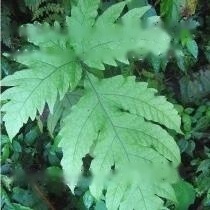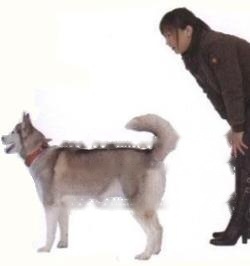
Chinese name: Yungui purple handle fern
Alternative name: Yunnan purple handle fern
Department: Ferns
Class: Pteridophyte
Order: Hyacinthidae
Family: Venus fernidae
1. Morphology of Yunnan purple-stalked fern
Yunnan purple handle fern is a large plant with a height of 1.5 meters. Rhizome stout (short and obliquely ascending); petiole 40-55 cm long, 5-7 mm thick, chestnut red, shiny, base densely covered with brown, ovate-lanceolate, hairy scales, smooth upward; leaf blade About 1 m long, 40-60 cm wide, ovate, apex acuminate and pinnatifid, not narrow to base, three-pinnatifid; pinnae 10 pairs or more, opposite, or nearly paired in upper part Raw, oblique, sessile, the largest pair at the base, 30-45 cm long, 13-20 cm wide, oblong-lanceolate, apex long acuminate, base asymmetrical, broadly cuneate, bipinnatifid; pinnae 15 -20 pairs, alternate, nearly spreading, the lower ones are separated from each other (the upper ones are connected by narrow wings), 2-3 cm apart, 6-13 cm long, 1.4-2.4 cm wide, lanceolate, acutely pointed, base broad wedge.
2. Habits of P. yunnanensis
P. yunnanensis grows in seaside, pond, paddy field or wetland grass. The vast majority of ferns are herbaceous plants, and very few species, such as cypress, can grow to a height of several meters to more than ten meters. The veins of ferns are relatively simple, and the current ferns are the most evolved spore plants. The sporophyte is well developed, with true differentiation of roots, stems and leaves. Most ferns are perennial herbs, and only a few are annuals.
3. Planting of P. yunnanensis
The common propagation methods of P. yunnanensis include spore propagation, ramet propagation and tissue culture, among which small area production can be used. The division method is used, and tissue culture is usually used for large-scale production. Propagation by division is usually carried out in combination with repotting in spring. Remove plants from pots and divide one into several plants, each with roots and leaves, as needed. Be careful when dividing plants, do not damage the growing point, keep the original soil of the roots as much as possible, cut off senescent and damaged leaves and roots, and plant according to the original planting depth. There are no strict seasonal requirements for ramet propagation, and it can be carried out all year round. In different growth stages, the requirements for light are different. Generally, the early stage of growth is the germination period, so it is necessary to prevent the light from being too strong and provide more shade. During the dormant period, place it in a well-lit place. Most ferns like to reflect and scatter light. If there is insufficient light, the plant will grow leggy and appear weak or wilted.
Guess you like it
Duckweed | Cattail | Cigu | White grass| Yellow calamus|Water bamboo leaves|
Dai|Da Ping| Black algae| | Wildflower | Wildflower | Kidney fern | Ficus lobularis | Pteridophyte|
Mosaic vine | Chestnut fern | Mosaic Reed Bamboo| Aspergillus| CrosspondSnake| Sleeping Vegetable| Wild Ling| water lilac | water shield grass | water poppy | small floating lotus | jade cicada |
![[Dog Training 5] The training method of pet dog dining etiquette](/static/img/12192/12192_1.jpg)




